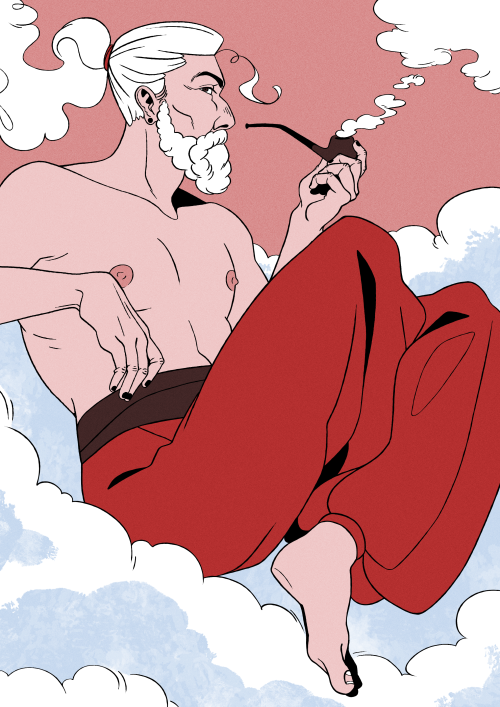#ukrainian folklore
Day 3: Cloud
Stryboh (also Strybailo and Posvystach), the god of the winds
(ID under the cut)
[ID:
An artwork of a shirtless old man sitting cross-legged in the clouds. The palette is mostly red with light-blue shadows on the clouds. The man is relaxed. His face is in profile. He has long hair gathered in a ponytail, it dissipates into clouds. He also has a lush beard that resembles clouds. He wears wide red pants (sharovary or sirwal). In his left hand he holds a tobacco pipe, from which small clouds arise.
End ID.]
Post link
Transformation [monotyping]
An artwork inspired by Ukrainian folklore, the figures are: a girl who is transforming into a mermaid and her father.
Monotyping is a technique where paint is spread on the paper to form random blobs which are then used as a silhouette for lining.
(ID under the cut.)
[ID:
An artwork and three closer shots of it showing details. Watercolor monotyping using yellow, green and pale red. Lines are done digitally in black. Cell shading is done digitally in purple. There is two floating human figures wearing traditional Ukrainian attire. One is an old man with dark curly hair, bushy eyebrows and a moustache. He has prominent cheekbones and a big curved nose. His wears a hat called kuchma, a coat with a belt, an embroidered shirt called vyshyvanka underneath, wide pants called sharovary and black boots. The other figure is a young woman with long wavy hair that floats upwards, bushy eyebrows and thick lip hair. She has a flower crown made with poppies and wheat with multiple ribbons at the bottom. She wears a vyshyvanka with an elaborate geometrical ornament on the collar and both sleeves, a skirt with plahta and boots. Behind one of the legs there is a shape reminiscent of a mermaid fish tail. Both of the figures have ear jewelry. The man reassuringly holds the woman’s hands in his own. There is a sun between their faces and a few strangely shaped water droplets in the air around them.
End ID.]
Post link
Hey folklore side of Tumblr, I accidentally found a collection of Ukrainian dumy (epic poems/ ballads) with English translations if anyone is interested:
http://lab.chass.utoronto.ca/rescentre/slavic/ukr/Cossacks/Ukrainian%20Dumy.pdf
haven’t looked at them all yet but the translation of Marusia of Boguslav is pretty accurate at least
I have been making my way through this at an absolute snail’s pace, because I‘m really not well practiced at reading epic poetry, but I appreciate you tagging me so much!
This is probably me not doing the tragic ballads about the heroes of Cossack Ukraine enough justice, but my favourite so far is the one about the “hapless, homeless falcon-child”, who gets put in silver chains and pearls but is freed again. It reminds me of Andersen’s Chinese Nightingale and even the translation has a good rhythm. I like ode’s to freedom that feature compassion.
I can’t get the link above to work anymore but the book in question is: Ukrainian Dumy (1979), translated by G. Tarnawsky and P. Kilina.
The whole website seems like a fantastic resource. The English bibliography mentioned a couple collections of folk tales that I kind of desperately want to get my hands on now:
- Ukrainian Folk Tales. (1964) Tr. by Marie Halun Bloch from the original collections of Ivan Rudchenko and Maria Lukiyanenko.
- The Flying Ship and other Ukrainian Folk Tales. (1975) Tr. by Victoria Symchych and Olga Vesey.
- Ukrainian Folk Tales. (1981) Tr. by Irina Zheleznova.
If I manage to find and read any I will of course report back!
When it comes to gender ideology of the childbirth – the act in which a woman partakes on both the body level and the ritual level, this act is implicitly associated with death. The realms of birth and death are seen as equal and are perceived as transitional and liminal events that result in the balance shift in the universe. For the parturient woman it was forbidden to take part in the community by all kinds of prohibitions for two to six weeks. As the people say, during this time “her grave does not close”.
From “Midwife in the cultural and historical tradition of Ukrainians” by Olena Boriak
“At six weeks old, the child is similar to an angel: it knows neither good nor evil. Although it laughs in its sleep, it isn’t laughing on its own: a good spirit possesses it and shows it rainbows, and the angel entertains it and makes it rejoice at the thought that it doesn’t owe anything to anyone yet.
Angels love to play with children. Sometimes when the cradle sways by itself people say that it’s an angel swaying the cradle. Angels entertain and tease little children.
To make a child laugh, they say: ‘’we’ll take the father, take the father!’’ and the child laughs because it doesn’t know yet that it needs father. And as they say ‘’we’ll take the mother!’’ – now it starts to cry and whimper. It is all done in a dream.”
From “The child in the customs and beliefs of the Ukrainian people” by Marko Hrushevsky


![Transformation [monotyping] An artwork inspired by Ukrainian folklore, the figures are: a girl who i Transformation [monotyping] An artwork inspired by Ukrainian folklore, the figures are: a girl who i](https://64.media.tumblr.com/ac961ba10969607fad4ff28e8885ace5/61fb5a887bcc4764-e6/s500x750/29fd1b24b23a4284f2c02b90655ab6b9a422c963.jpg)
![Transformation [monotyping] An artwork inspired by Ukrainian folklore, the figures are: a girl who i Transformation [monotyping] An artwork inspired by Ukrainian folklore, the figures are: a girl who i](https://64.media.tumblr.com/484997a537df6b8cc91bd1b7c20f52e6/61fb5a887bcc4764-56/s500x750/38978c9876b78b902edec18dd8a6bbd3f0bb57d3.png)
![Transformation [monotyping] An artwork inspired by Ukrainian folklore, the figures are: a girl who i Transformation [monotyping] An artwork inspired by Ukrainian folklore, the figures are: a girl who i](https://64.media.tumblr.com/ec960c866861b40e68dbb09adbaa724d/61fb5a887bcc4764-5d/s500x750/6b63242d33f256b295edfedaaa2682ededc46a67.png)
![Transformation [monotyping] An artwork inspired by Ukrainian folklore, the figures are: a girl who i Transformation [monotyping] An artwork inspired by Ukrainian folklore, the figures are: a girl who i](https://64.media.tumblr.com/69bc6146ccad9d7595975fabed86b3e7/61fb5a887bcc4764-45/s500x750/9d5bd35150bff969e3dcc3ced22c2ddfe20a8f06.png)